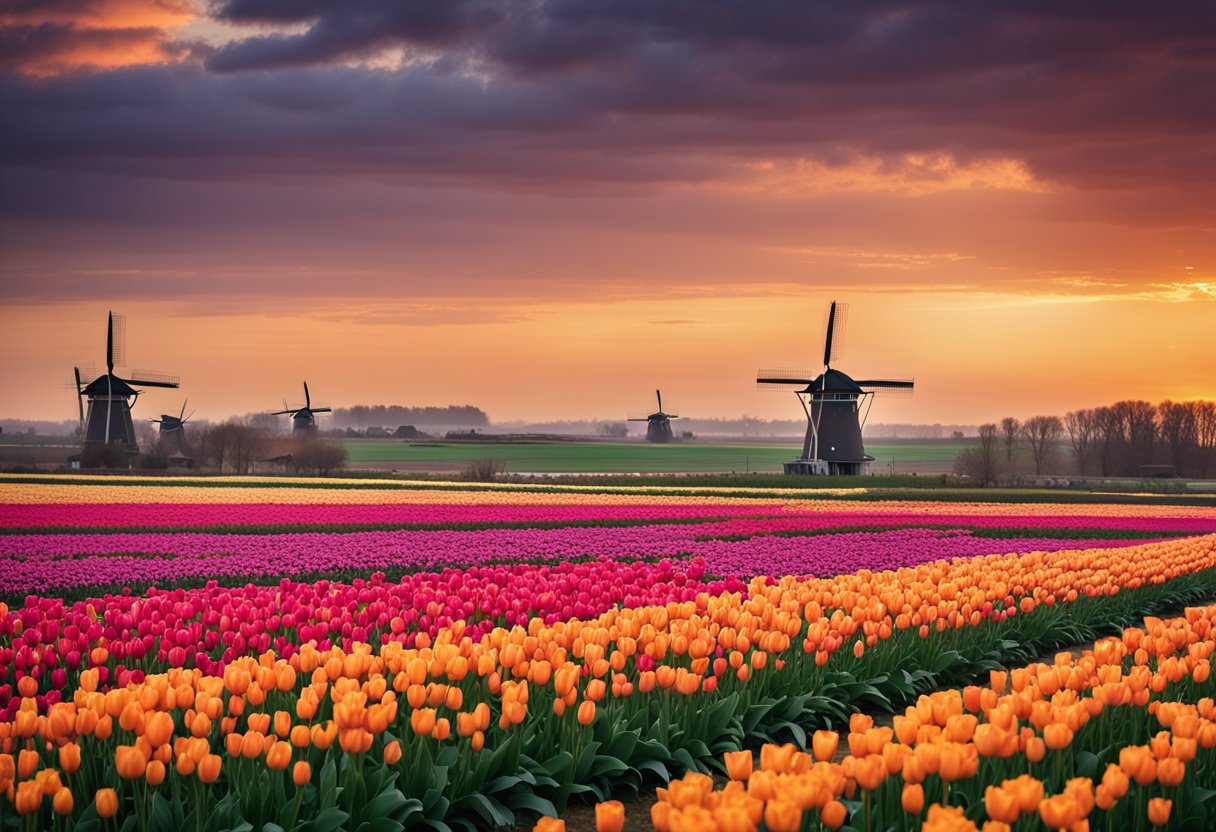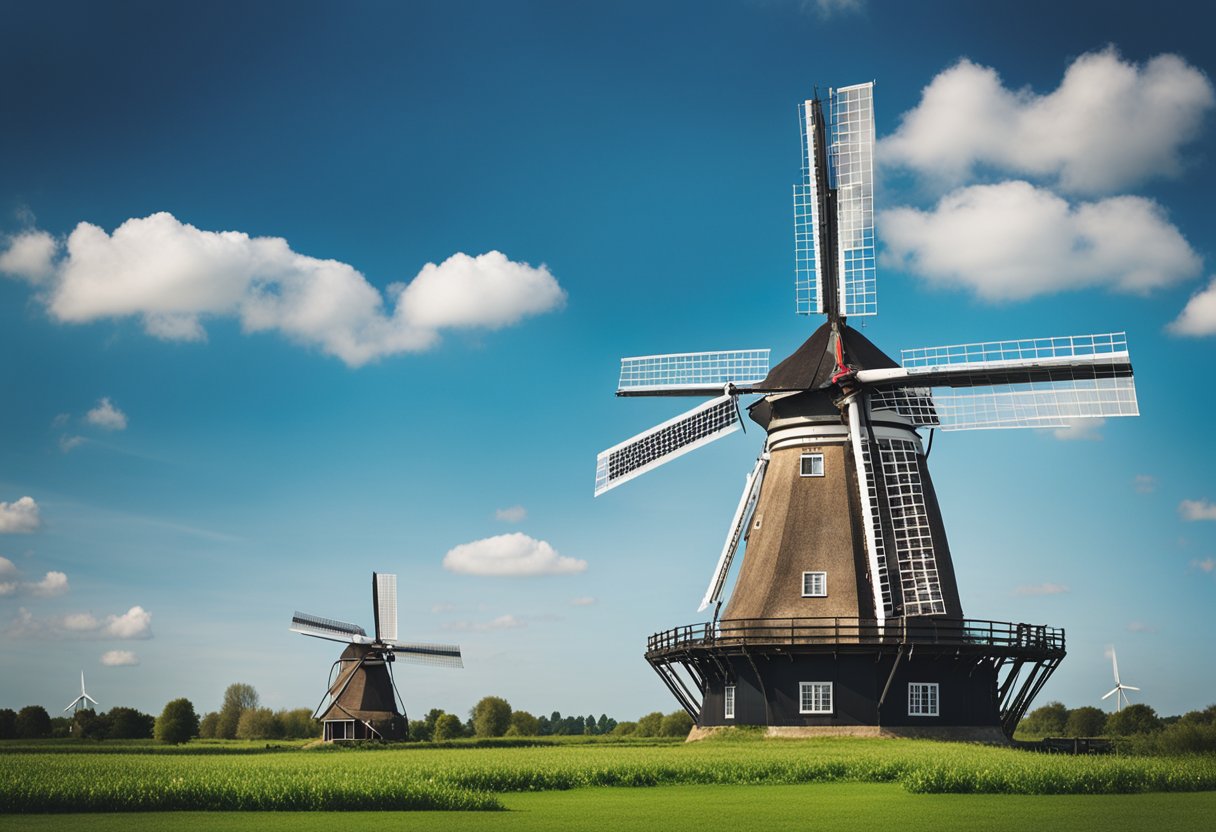Discover The Iconic Windmills of the Netherlands: Dutch Legacy and Technical Marvels
Updated On: March 21, 2024 by Fatma Mohamed
The Netherlands, with its vast and serene landscapes, is indelibly associated with windmills, an enduring emblem of Dutch heritage and engineering prowess. These structures have stood the test of time, not merely as picturesque backdrops but also as integral components of Dutch history. They showcase the intricate relationship between humans and the environment, illustrating a legacy where traditional engineering has effectively managed water and supported industry. We take pride in these monumental structures for their historical significance, their contribution to the country’s water management and flood control, and the way they’ve shaped the cultural landscape.

Historically, windmills in the Netherlands played a crucial role in water management, a necessity in a land that battled the sea for territory. They also powered various industries, which contributed significantly to the Dutch economy. Today, many of these windmills have been preserved, some achieving UNESCO World Heritage status, serving as a testament to their importance. They are not mere relics of the past; instead, they remain active in Dutch culture and tourism, providing insights into old and new adaptations of wind power. Their presence continues to speak volumes about the ingenuity and resilience of Dutch engineering.
Table of Contents
The Historical Significance of Dutch Windmills
Windmills stand as testaments to our ingenuity, adapting to the Netherlands’ unique environment. They’ve played a pivotal role in our nation’s survival, development, and identity.
Emergence and Evolution
Our history with windmills dates back to the 13th century, a time when our ancestors faced the challenge of frequent floods in low-lying areas. The emergence of windmills was a response to the necessity of draining these lands, a task vital for the survival and growth of Dutch settlements. This impressive feat of engineering enabled us to reclaim land from the control of the sea and rivers, earning the windmill its place in the pantheon of Dutch heritage.
Over the centuries, these structures evolved beyond water management. By the 19th century, innovations had transformed windmills into factories capable of a variety of tasks, from sawing wood to grinding grain. They became cornerstones of Dutch industrial potential, allowing us to thrive in areas such as the grain milling industry, as evidenced in the history of grain milling in Schiedam’s Jenever distilleries found through Culture Trip.
Windmills and Dutch Identity
The windmill is more than a mere structure—it’s a symbol woven into the very fabric of our culture. These iconic edifices represent the Dutch spirit of innovation, resilience, and adaptation in the face of adversity. Their presence tells the story of people who have not just mastered their environment but have flourished within it. Our cultural identity is closely linked to the existence and the image of the windmill.
Recognised across the world as an integral part of our landscape, the windmill reflects the Dutch ethos of living harmoniously with nature. Even in contemporary times, they stand across our countryside, not solely as tourist attractions but as proud reminders of our past. As shared by Dutch Countryside, despite being eclipsed by modern technology, windmills remain indelible marks of our resilience and innovative spirit. They draw countless visitors, fascinated by both their engineering and their quintessential role in shaping the Dutch nation.
Engineering Marvels of the Windmills
The iconic windmills of the Netherlands are not just picturesque staples dotting the landscape; they are masterpieces of engineering and design. These structures reflect the Dutch ingenuity, especially in water management, that has been crucial for a country where land and water intertwine.
Design and Construction
The traditional Dutch windmills showcase a robust combination of timber and stone construction techniques. Our ancestors utilised local materials to create the towering windmill structures, which have withstood the test of time. The interplay between timber’s flexibility and stone’s sturdiness was pivotal to endure the constant motion and torque exerted on these mills by the wind.
Historical records suggest that the Dutch began to erect windmills as early as 1,200 AD, with design improvements continuously integrated over the centuries. The brilliance of these constructions lies as much in their aesthetic appeal as in their functional design, which has been optimised to harness the power of the wind effectively.
Innovations in Water Management
The ingenuity of Dutch water management is exemplified by the engineering of windmills that intricately manage the levels of water throughout the lowlands. Notably, the Kinderdijk windmills serve as classic examples of historical innovations implemented to keep areas dry that would otherwise be submerged. These windmills, driven by wind power, activated a system of screws and pumps to move water from the polders back into the rivers and thus prevent flooding.
The Delta Works project, though a more modern feat, is nonetheless rooted in the same principles of managing aquatic forces that guided historical windmill construction. The need for such ingenious water management arose starkly after the catastrophic flood of 1953, highlighting the enduring relevance of these engineering marvels in Dutch society.
Iconic Windmill Sites in the Netherlands
The Netherlands is home to some of the most remarkable windmill sites in the world, where the legacy of Dutch engineering and the natural beauty of the countryside come together. These sites not only encapsulate the historical significance of windmills in Dutch culture but also continue to draw tourists from all over who come to witness these engineering marvels and picturesque landscapes.
Kinderdijk-Elshout
Kinderdijk is a renowned UNESCO World Heritage Site, celebrated for its impressive array of 19 windmills. The site stands as a testament to the ingenious water management systems that have kept Dutch feet dry for centuries. Moreover, the windmills of Kinderdijk, nestled in the lush greenery and waterways, comprise one of the most photographed places in the Netherlands, inviting visitors to their idyllic setting.
Zaanse Schans
Moving to the province of North Holland, the Zaanse Schans is a vibrant and fully operational windmill park. It offers a peek into 18th-century Dutch life with its historic windmills and distinctive green wooden houses. Known for its picturesque charm, Zaanse Schans allows guests to experience traditional Dutch crafts and see the windmills in action.
Schermerhorn and the North Holland Region
The Schermerhorn windmills, along with others scattered across the North Holland region, underscore the historical role of windmills in this part of the Netherlands. Schermerhorn’s network of polder windmills is intrinsic to the landscape and has played a key role in land reclamation and management in the area. The region’s commitment to preserving these structures showcases the enduring beauty and functionality of Dutch windmills.
These iconic windmill sites are more than mere tourist attractions; they embody Dutch heritage and contribute significantly to the scenic and cultural landscape that we are proud to share with visitors from around the world.
Windmill-Powered Industries and Their Impact
In the Netherlands, windmills have long been at the heart of innovative industrial applications, particularly in grain milling, timber processing, and jenever distillation. They played a critical role in transforming the economy and shaping the industrial landscape.
Grain Milling and Agriculture
Windmills significantly bolstered the Dutch economy by enhancing grain production. Millers were vital in operating these structures and ensuring the efficient milling of grain. The end product not only supported local agriculture but also fed into the growing food markets, solidifying the country’s economic strength.
Timber Sawing and Papermaking
The industry of timber sawing flourished with the advent of wind-powered sawmills, improving the processing and production of wood products. This innovation spurred the papermaking industry as well, which relied on pulped wood, bolstering both these sectors and contributing to an industrial revolution of sorts in the region.
Jenever Distilling in Schiedam
Schiedam became famous for its windmill-powered jenever distilleries, highlighting the versatility of windmills beyond milling and sawing. These towering structures were instrumental in producing the Dutch spirit, further diversifying the use of wind-powered technology in the nation’s industry.
Preservation and UNESCO Heritage Status
Our attention is turning towards the significance of the preservation and the acclaim the windmills of the Netherlands have received through their UNESCO World Heritage status.
Conservation Efforts
Conservation of these historical windmills isn’t merely a cultural preference; it’s a necessity. Through the collaboration between local authorities and heritage organisations, we are witnessing painstaking efforts to maintain and restore the windmills of Kinderdijk, ensuring their survival for future generations. These efforts range from routine maintenance to comprehensive refurbishments, all in service of preserving the original mechanisms and structures that have withstood the test of time.
Recognition and Responsibility
The Kinderdijk windmills were recognised as a UNESCO World Heritage site in 1997, a testament to their value as a piece of our collective heritage. This status brings global responsibility to uphold conservation measures and promote awareness of their historical significance. It’s not only a recognition of the past but a commitment to sustainable preservation, as these windmills continue to symbolise Dutch water management ingenuity.
Dutch Windmills as Tourist Attractions
The historic windmills of the Netherlands offer a quintessential Dutch experience to visitors, combining heritage with picturesque landscapes. They stand as symbols of Dutch engineering and are integral to the country’s tourism industry.
Visiting the Windmills of Kinderdijk
The Kinderdijk windmills are a must-see for anyone on a day trip to the Netherlands. As a UNESCO World Heritage Site, this collection of 19 windmills presents a spectacular view of Dutch hydraulic engineering. Numerous tourists capture this iconic scene on their cameras, often finding their shots as compelling as any postcard image of the Netherlands.
Dutch Windmills Beyond the Postcard Image
While Kinderdijk is renowned worldwide, there’s more to explore beyond the typical postcard representation of Dutch windmills. In places like Schiedam, visitors can see some of the tallest traditional windmills in the world. Moreover, attractions like the Zaanse Schans provide a glimpse into the historical importance of windmills in the Dutch way of life, from agriculture to industry. These sites not only showcase the engineering prowess of past generations but also ensure the continued relevance of windmills in Dutch culture and tourism.
Water Management and Flood Control
In the Netherlands, a country well-versed in the intricacies of water management, the battle against flooding has been shaped by both traditional methods and modern engineering.
The Role of Windmills in Polder Drainage
Windmills have historically played a crucial role in the Dutch water management system. These structures were not only cultural symbols but also pragmatic tools for draining polders — tracts of land reclaimed from the sea or lakes and enclosed by dikes. By converting wind power into mechanical energy, windmills enabled the pumping of water from these low-lying lands into nearby rivers or canals, thus preventing flooding and creating arable land for agriculture.
Advancements in Dutch Hydraulic Engineering
As technology progressed, the Netherlands embraced new methods to manage water and control flooding. The windmill-laden landscapes gave way to modern pumping stations, which continue the legacy of drainage but with far greater efficiency and control. Sophisticated hydraulic engineering techniques now protect the Dutch waterways, integrating advanced flood barriers and surge protectors that ensure the water management system copes with both natural and human-made changes in our dynamic environment.
Accessing Windmills: Transportation and Facilities
When visiting the iconic windmills of the Netherlands, knowing how to get there and what amenities are available enhances the experience. Convenient access and comprehensive tourist facilities allow visitors to immerse themselves in Dutch heritage and engineering marvels.
Public Transport and Road Access
Public transportation provides efficient routes to the windmill sites. For example, to visit the windmills at Kinderdijk, buses operate regularly from nearby cities, seamlessly connecting travellers to a piece of Dutch history. For those arriving by car, adequate parking facilities are available, ensuring a stress-free experience. In some locations, taking a boat offers scenic routes to the windmills, adding a unique perspective to the journey.
In Amsterdam, the windmill of De Gooyer, which is linked to a renowned local brewery, is within easy reach by bicycle, blending a cultural visit with casual leisure. Cyclists find ample bicycle parking spaces, evidencing the Netherlands’ bike-friendly culture.
Tourist Facilities and Activities
Upon arrival, visitors are greeted with a range of facilities aimed at enhancing their experience. At UNESCO World Heritage sites like Kinderdijk, guided tours reveal the intricate workings and purpose of the windmills. The site’s visitor centre provides educational insights, complete with models and exhibits, to satisfy the tourists’ curiosity about how these windmills have stood the test of time.
Interactive activities, such as watching milling in action or venturing inside a working windmill, provide hands-on learning opportunities. Visitors can enjoy these activities knowing they have access to convenient amenities, including rest areas and food services, which cater to the needs of individuals and families alike.
The Cultural Experience of Windmills

We find that the windmills in the Netherlands offer a deep dive into Dutch culture, providing insights not only into the nation’s engineering marvels but also into its social and cultural fabric. These historical structures are pivotal in cultural events and education, offering a window into the past through present-day celebrations and learning opportunities.
Events and Celebrations
National Mill Day is an event where windmill enthusiasts across the Netherlands can experience windmills in full operation. Held annually during the second weekend of May, this event sees over 950 windmills and watermills open their doors to the public. Visitors are treated to a plethora of activities, including milling demonstrations and a glimpse into the life of a miller. Local food, music, and dance often accompany these festivities, showcasing the traditional Dutch way of living.
Educational Programmes and Demonstrations
Educational programmes are integral to maintaining the legacy of Dutch windmills. At places like Zaanse Schans, visitors can engage in interactive experiences that elucidate the science and history behind these engineering wonders. Demonstrations include showing how mills are operated and the process of crafting products like flour and oil. These programmes often cater to both children and adults, ensuring that the educational value of windmills is passed on to future generations, preserving the Dutch heritage.
Adaptation and Modern Uses of Windmills
The Dutch windmills, once paramount for industrial growth, have transitioned into varied roles that reflect both historical reverence and forward-thinking innovation.
From Grain to Electricity Generation
Windmills were originally engineered to process raw materials, such as grinding grain or draining land. Today, these structures have been adapted to play a central role in sustainable development: electricity generation. The Netherlands is now home to more than 2,600 modern wind turbines that harness wind power to produce clean energy, demonstrating a blend of heritage and environmental stewardship.
Windmills in Contemporary Dutch Life
In contemporary Dutch society, windmills stand as monuments to the nation’s ingenuity and persistence. The surviving traditional windmills are cared for by enthusiastic volunteers, ensuring that their historical and educational value endures amidst the fast-paced evolution of Dutch life. Occupying an esteemed place in the landscape, these windmills continue to fascinate visitors and serve as a link between past accomplishments and current aspirations.
Frequently Asked Questions

In this section, we aim to address common queries related to the enduring heritage and remarkable engineering of the Dutch windmills.
What functions have the Dutch windmills traditionally served?
Historically, Dutch windmills have been crucial in water management, notably for draining land for agriculture and later for milling grain. They’ve been an indispensable tool in the Netherlands’ battle against water.
Which are some of the most renowned windmills in the Netherlands?
The windmills of Kinderdijk, a UNESCO World Heritage Site, stand as a high point of Dutch windmill fame. Others include the windmills of Zaanse Schans and Schiedam, which are also significant landmarks.
Can you explain how windmills operate in the Netherlands?
Windmills in the Netherlands work by harnessing wind energy to turn large wheels or gears, which are connected to systems for draining water or grinding grains. In essence, these structures convert wind power into useful mechanical work.
What is the significance of windmills in Dutch culture and heritage?
Windmills are a symbol of the Dutch struggle with water and are deeply ingrained in their cultural identity. They represent the innovation and resilience of the Dutch people and are celebrated elements of the Netherlands’ heritage.
How has the design and engineering of Dutch windmills evolved?
Over the centuries, the design and engineering of Dutch windmills have evolved to improve efficiency and adapt to various tasks. From the simple post mills to the large tower and smock mills with rotating caps, innovation has been constant to enhance their functionality.
Approximately how many historical windmills remain in the Netherlands today?
Today, there are around 1,000 historic windmills still standing in the Netherlands. These structures continue to be maintained, with some still being used for their original purposes, and others serving as educational sites.






